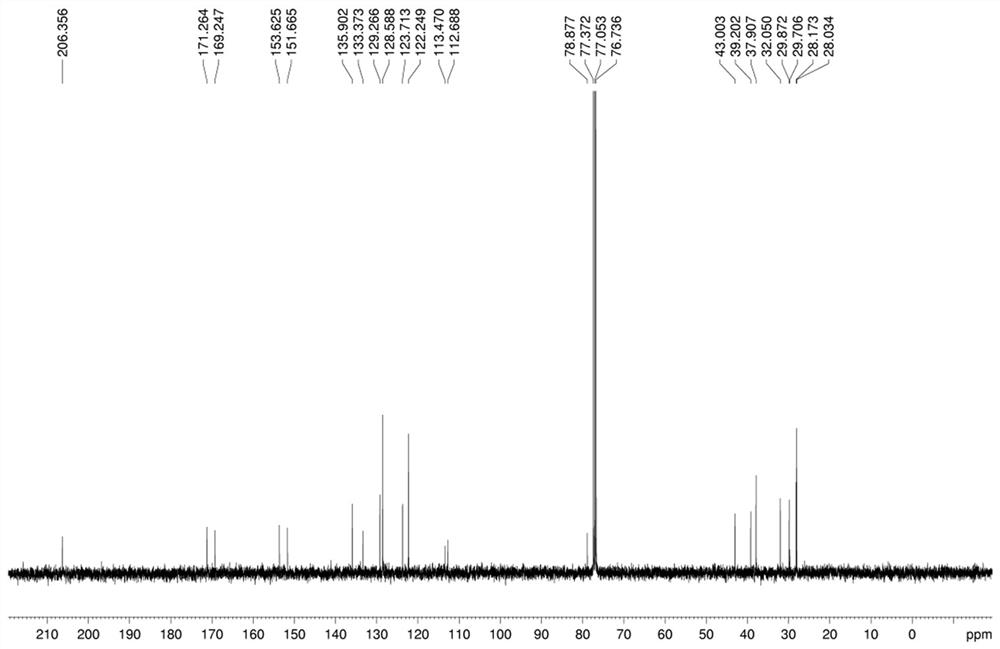Preparation method and application of a near-infrared fluorescent probe for detecting selenite
A fluorescent probe and near-infrared technology, which is applied in the field of preparation of near-infrared fluorescent probes, can solve the problems of failing to meet the requirements for detecting selenite, low detection limit, and inability to use anionic selenite for detection.
- Summary
- Abstract
- Description
- Claims
- Application Information
AI Technical Summary
Problems solved by technology
Method used
Image
Examples
preparation example Construction
[0036] The preparation method of intermediate 1 is:
[0037] .
[0038] Commercial raw materials (3,5,5-trimethylcyclohex-2-enylidene) malononitrile (compound A, 186 mg, 1 mmol) and p-hydroxybenzaldehyde (244 mg, 2 mmol) were dissolved in 6 One to two drops of piperidine and acetic acid were added dropwise to the above system in mL of ethanol solution, heated to reflux for 4 hours, and cooled to room temperature after the reaction was complete as monitored by TLC. The above reaction solution was poured into 15 ml of ice-water mixture, and a precipitate was formed. The precipitate was filtered out and redissolved in dichloromethane, and the product was separated by column chromatography to obtain a yellow solid product which was intermediate 1 (203 mg), and the yield was 70%.
Embodiment 1
[0040] The preparation method of the near-infrared fluorescent probe of the detection selenite of the present embodiment, the steps are:
[0041] Levulinic acid (116.0 mg, 1.0 mmol) was dissolved in 10 mL of anhydrous dichloromethane, EDC (96 mg, 0.5 mmol) and DMAP (12.2 mg, 0.1 mmol) were added and stirred at room temperature for 10 minutes. Dissolve Intermediate 1 (145 mg, 0.5 mmol) in 10 mL of anhydrous dichloromethane solution, add it dropwise to the above mixed solution at room temperature, react for 8 hours after the dropwise addition, and wash the reaction solution with 10 mL of saturated chlorine The sodium chloride solution was washed 3 times, the organic phase was dried with anhydrous sodium sulfate, filtered, the solvent was removed under reduced pressure, ethyl acetate and petroleum ether were used as detergents (volume ratio 1:3), and 77.6 mg product SeP1, 40% yield.
[0042] NMR determination: 1 H NMR (CDCl 3 , 400 MHz) δ 1.10 (s, 6 H), 2.25 (s, 3 H),2.48 (s, ...
Embodiment 2
[0045] The preparation method of the near-infrared fluorescent probe of the detection selenite of the present embodiment, the steps are:
[0046] Levulinic acid (116.0 mg, 1.0 mmol) was dissolved in 10 mL of anhydrous dichloromethane, EDC (192 mg, 1 mmol) and DMAP (61 mg, 0.5 mmol) were added and stirred at room temperature for 20 minutes. Dissolve intermediate 1 (290 mg, 1 mmol) in 15 mL of anhydrous dichloromethane solution, add it dropwise to the above mixed solution at room temperature, react for 10 hours after the dropwise addition, and use 10 mL of saturated chlorinated The sodium solution was washed 3 times, the organic phase was dried with anhydrous sodium sulfate, filtered, the solvent was removed under reduced pressure, ethyl acetate and petroleum ether were used as detergents (volume ratio 1:6), and 213.4 mg was obtained by silica gel column chromatography The product SeP1, namely the fluorescent probe, has a yield of 55%.
[0047] NMR determination of fluorescent ...
PUM
| Property | Measurement | Unit |
|---|---|---|
| emission peak | aaaaa | aaaaa |
Abstract
Description
Claims
Application Information
 Login to View More
Login to View More - R&D
- Intellectual Property
- Life Sciences
- Materials
- Tech Scout
- Unparalleled Data Quality
- Higher Quality Content
- 60% Fewer Hallucinations
Browse by: Latest US Patents, China's latest patents, Technical Efficacy Thesaurus, Application Domain, Technology Topic, Popular Technical Reports.
© 2025 PatSnap. All rights reserved.Legal|Privacy policy|Modern Slavery Act Transparency Statement|Sitemap|About US| Contact US: help@patsnap.com



